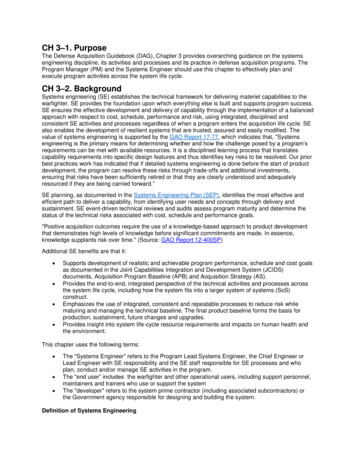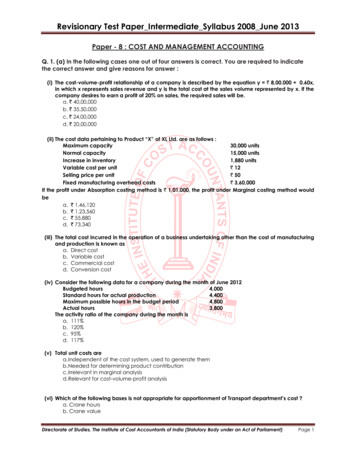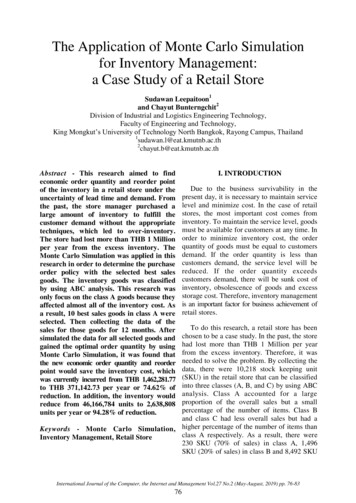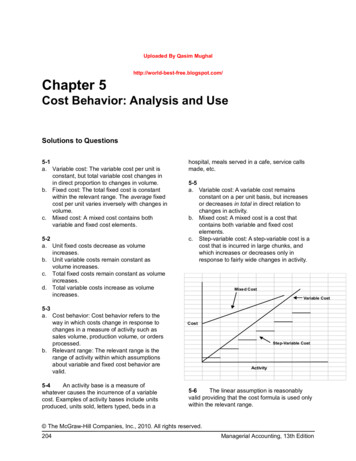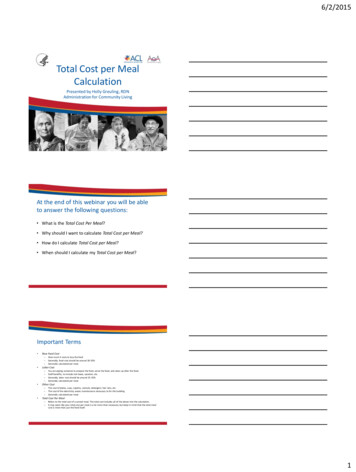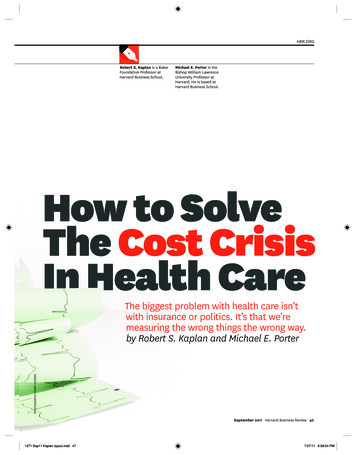
Transcription
HBR.ORGRobert S. Kaplan is a BakerFoundation Professor atHarvard Business School.Michael E. Porter is theBishop William LawrenceUniversity Professor atHarvard. He is based atHarvard Business School.How to SolveThe Cost CrisisIn Health CarePHOTOGRAPHY: MARK HOOPERThe biggest problem with health care isn’twith insurance or politics. It’s that we’remeasuring the wrong things the wrong way.by Robert S. Kaplan and Michael E. PorterSeptember 2011 Harvard Business Review 471271 Sep11 Kaplan layout.indd 477/27/11 6:08:04 PM
THE BIG IDEA HOW TO SOLVE THE COST CRISIS IN HEALTH CAREU.S. health care costscurrently exceed 17% ofGDP and continue to rise.Other countries spend less of their GDP on health carebut have the same increasing trend. Explanations arenot hard to find. The aging of populations and the development of new treatments are behind some of theincrease. Perverse incentives also contribute: Thirdparty payors (insurance companies and governments)reimburse for procedures performed rather than outcomes achieved, and patients bear little responsibilityfor the cost of the health care services they demand.But few acknowledge a more fundamental sourceof escalating costs: the system by which those costsare measured. To put it bluntly, there is an almostcomplete lack of understanding of how much it coststo deliver patient care, much less how those costscompare with the outcomes achieved. Instead offocusing on the costs of treating individual patientswith specific medical conditions over their full cycleof care, providers aggregate and analyze costs at thespecialty or service department level.Making matters worse, participants in the healthcare system do not even agree on what they mean bycosts. When politicians and policy makers talk aboutcost reduction and “bending the cost curve,” they aretypically referring to how much the government orinsurers pay to providers—not to the costs incurredby providers to deliver health care services. Cuttingpayor reimbursement does reduce the bill paid byinsurers and lowers providers’ revenues, but it doesnothing to reduce the actual costs of delivering care.Providers share in this confusion. They often allocatetheir costs to procedures, departments, and servicesbased not on the actual resources used to deliver carebut on how much they are reimbursed. But reimbursement itself is based on arbitrary and inaccurateassumptions about the intensity of care.Poor costing systems have disastrous consequences. It is a well-known management axiom thatwhat is not measured cannot be managed or improved. Since providers misunderstand their costs,they are unable to link cost to process improvementsor outcomes, preventing them from making systemic and sustainable cost reductions. Instead, providers (and payors) turn to simplistic actions suchas across-the-board cuts in expensive services, staffcompensation, and head count. But imposing arbitrary spending limits on discrete components of care,or on specific line-item expense categories, achievesonly marginal savings that often lead to higher totalsystems costs and poorer outcomes. For example, aspayors introduce high copayments to limit the use ofexpensive drugs, costs may balloon elsewhere in thesystem should patients’ overall health deteriorateand they subsequently require more services.Poor cost measurement has also led to hugecross-subsidies across services. Providers are generously reimbursed for some services and incur losseson others. These cross-subsidies introduce majordistortions in the supply and efficiency of care. Theinability to properly measure cost and compare costwith outcomes is at the root of the incentive problemin health care and has severely retarded the shift tomore effective reimbursement approaches.Finally, poor measurement of cost and outcomesalso means that effective and efficient providers gounrewarded, while inefficient ones have little incentive to improve. Indeed, institutions may be penalizedwhen the improvements they make in treatmentsand processes reduce the need for highly reimbursedservices. Without proper measurement, the healthydynamic of competition—in which the highest-valueproviders expand and prosper—breaks down. Instead we have zero-sum competition in which healthcare providers destroy value by focusing on highlyreimbursed services, shifting costs to other entities,or pursuing piecemeal and ineffective line-item costreductions. Current health care reform initiatives willexacerbate the situation by increasing access to an inefficient system without addressing the fundamental48 Harvard Business Review September 20111271 Sep11 Kaplan layout.indd 487/27/11 6:08:11 PM
HBR.ORGIdea in BriefMuch of the rapid escalationin health care costs can beattributed to the fact thatproviders have an almostcomplete lack of understanding of how much it costs todeliver patient care. Thusthey lack the knowledge necessary to improve resourceutilization, reduce delays,and eliminate activities thatdon’t improve outcomes.value problem: how to deliver improved outcomes ata lower total cost.Fortunately, we can change this state of affairs.And the remedy does not require medical sciencebreakthroughs or top-down governmental regulation. It simply requires a new way to accurately measure costs and compare them with outcomes. Ourapproach makes patients and their conditions—notdepartmental units, procedures, or services—thefundamental unit of analysis for measuring costs andoutcomes. The experiences of several major institutions currently implementing the new approach—theHead and Neck Center at MD Anderson Cancer Center in Houston, the Cleft Lip and Palate Program atChildren’s Hospital in Boston, and units performingknee replacements at Schön Klinik in Germany andBrigham & Women’s Hospital in Boston—confirm ourbelief that bringing accurate cost and value measurement practices into health care delivery can have atransformative impact.Understanding theValue of Health CareThe proper goal for any health care delivery systemis to improve the value delivered to patients. Valuein health care is measured in terms of the patientoutcomes achieved per dollar expended. It is notthe number of different services provided or the volume of services delivered that matters but the value.More care and more expensive care is not necessarilybetter care.To properly manage value, both outcomes andcost must be measured at the patient level. Measuredoutcomes and cost must encompass the entire cycleof care for the patient’s particular medical condition,which often involves a team with multiple specialtiesperforming multiple interventions from diagnosis totreatment to ongoing management. A medical condition is an interrelated set of patient circumstancesPilot projects under way athospital systems in the U.S.and Europe demonstrate thetransformative effect of anew approach that accurately measures costs—atthe level of the individualpatient with a given medicalcondition over a full cycle ofcare—and compares thosecosts to outcomes.The remedy tothe cost crisisdoes not requiremedical sciencebreakthroughs ornew governmentalregulation. It simplyrequires a newway to accuratelymeasure costs andcompare them withoutcomes.As providers and payorsbetter understand costs,they will be positioned toachieve a true “bending ofthe cost curve” from withinthe system, not based ontop-down mandates.The sheer size of the opportunity to reduce healthcare costs—with no sacrificein outcomes—is astounding.that are best addressed in a coordinated way andshould be broadly defined to include common complications and comorbidities. The cost of treating apatient with diabetes, for example, must include notonly the costs associated with endocrinological carebut also the costs of managing and treating associated conditions such as vascular disease, retinal disease, and renal disease. For primary and preventivecare, the unit of value measurement is a particularpatient population—that is, a group with similar primary care needs, such as healthy children or the frailand elderly with multiple chronic conditions.Let’s explore the first component of the healthcare value equation: health outcomes. Outcomes forany medical condition or patient population shouldbe measured along multiple dimensions, includingsurvival, ability to function, duration of care, discomfort and complications, and the sustainabilityof recovery. Better measurement of outcomes will,by itself, lead to significant improvements in thevalue of health care delivered, as providers’ incentives shift away from performing highly reimbursedservices and toward improving the health status ofpatients. Approaches for measuring health care outcomes have been described previously, notably inMichael Porter’s 2010 New England Journal of Medicine article, “What Is Value in Health Care?”While measuring medical outcomes has receivedgrowing attention, measuring the costs required todeliver those outcomes, the second component of thevalue equation, has received far less attention. In thevalue framework, the relevant cost is the total cost ofall resources—clinical and administrative personnel,drugs and other supplies, devices, space, and equipment—used during a patient’s full cycle of care for aspecific medical condition, including the treatmentof associated complications and common comorbidities. We increase the value of health care deliveredto patients by improving outcomes at similar costs orSeptember 2011 Harvard Business Review 491271 Sep11 Kaplan layout.indd 497/27/11 6:08:11 PM
THE BIG IDEA HOW TO SOLVE THE COST CRISIS IN HEALTH CAREby reducing the total costs involved in patients’ carewhile maintaining the quality of outcomes.A powerful driver of value in health care is thatbetter outcomes often go hand in hand with lower total care cycle costs. Spending more on early detectionand better diagnosis of disease, for example, sparespatients suffering and often leads to less complexand less expensive care later. Reducing diagnosticand treatment delays limits deterioration of healthand also lowers costs by reducing the resources required for care. Indeed, the potential to improve outcomes while driving down costs is greater in healthcare than in any other field we have encountered.The key to unlocking this potential is combining anaccurate cost measurement system with the systematic measurement of outcomes. With these powerfultools in place, health care providers can utilize medical staff, equipment, facilities, and administrative resources far more efficiently, streamline the path ofpatients through the system, and select treatmentapproaches that improve outcomes while eliminating services that do not.The Challenges of Health Care CostingAccurate cost measurement in health care is challenging, first because of the complexity of health caredelivery itself. A patient’s treatment involves manydifferent types of resources—personnel, equipment,space, and supplies—each with different capabilitiesand costs. These resources are used in processes thatstart with a patient’s first contact with the organization and continue through a set of clinical consulta-Myth #1Charges are a good surrogate for provider costs.The widespread confusion betweenwhat a provider charges, what it isactually reimbursed, and its costs is amajor barrier to reducing the cost ofhealth care. Providers have aggravatedthis problem by structuring important aspects of their costing systemsaround the way they are reimbursed.In the U.S., this is partly a historical artifact of the Medicare cost-plusreimbursement system, which requireshospital departments to prepare anannual Medicare Cost Report (MCR),detailing costs and charges by department. Rather than developing andmaintaining accurate costing systemsthat are based on actual resourceusage, separate from the regulatorystandard required for reimbursement,hospitals defaulted to reimbursementdriven systems.Unfortunately, that approach wasflawed from the start because it wasbased on the use of highly aggregatedata for estimating costs and the1271 Sep11 Kaplan layout.indd 50deeply flawed assumption that everybillable event in a department has thesame profit margin. Reimbursementbased costing also buries the costs ofvaluable but nonbillable events, suchas patient consultations, in large overhead pools that are allocated arbitrarilyand inaccurately to billable events.Although costing systems for physician services differ from those used byhospitals, they suffer from the sameproblems. As is the case for hospitals,U.S. physicians are reimbursed not onthe basis of an individual patient’s resource use but on average estimates ofrelative demands—relative value units,or RVUs—on physician labor, practiceexpenses, and malpractice expensesin performing billable activities. Theseresource estimates are derived fromspecialty panels and national surveysof physicians, who stand to gain fromoverestimating the time and complexity of their work. Despite the requiredsign-off by government payors, the RVUestimates are not systematically measured or confirmed in practice settings.Reimbursing physicians on the basis ofhighly aggregate and likely inaccurateestimates of their costs introducesmajor incentive problems into thehealth care system. But the problemsare compounded when the reimbursement rates are also used to allocatephysician costs to patients, a purposefor which they were never intended.We need to abandon the idea thatcharges billed or reimbursements paidin any way reflect costs. In reality, thecost of using a resource—a physician,nurse, case manager, piece of equipment, or square meter of space—is thesame whether the resource is performing a poorly or a highly reimbursedservice. Cost depends on how much ofa resource’s available capacity (time)is used in the care for a particular patient, not on the charge or reimbursement for the service, or whether it isreimbursed at all.7/27/11 6:08:12 PM
HBR.ORGFURTHER READINGFROM THE AUTHORStions, treatments, and administrative processes untilthe patient’s care is completed. The path that the patient takes through the system depends on his or hermedical condition.The already complex path of care is further complicated by the highly fragmented way in whichhealth care is delivered today. Numerous distinct andlargely independent organizational units are involvedin treating a patient’s condition. Care is also idiosyncratic; patients with the same condition often takedifferent paths through the system. The lack of standardization stems to some extent from the artisanalnature of medical practice—physicians in the sameorganizational unit performing the same medicalprocess (for instance, total knee replacement) oftenuse different procedures, drugs, devices, tests, andequipment. In operational terms, you might describehealth care today as a highly customized job shop.Existing costing systems, which measure thecosts of individual departments, services, or support activities, often encourage the shifting of costsfrom one type of service or provider to another, orto the payor or consumer. The micromanagement ofcosts at the individual organizational unit level doeslittle to reduce total cost or improve value—and mayin fact destroy value by reducing the effectiveness ofcare and driving up administrative costs. (For moreon the problems with current costing systems, seethe three Myth sidebars.)Any accurate costing system must, at a fundamental level, account for the total costs of all the resourcesused by a patient as she or he traverses the system.That means tracking the sequence and duration ofclinical and administrative processes used by individual patients—something that most hospital information systems today are unable to do. This deficiencycan be addressed; technology advances will soongreatly improve providers’ ability to track the typeand amount of resources used by individual patients.In the meantime, it is possible to determine the predominant paths followed by patients with a particularmedical condition, as our pilot sites have done.With good estimates of the typical path an individual patient takes for a medical condition, providers can use the time-driven activity-based costing(TDABC) system to assign costs accurately and relatively easily to each process step along the path. Thisimproved version of activity-based costing requiresthat providers estimate only two parameters at eachprocess step: the cost of each of the resources usedin the process and the quantity of time the patientMEASURING VALUEAND OUTCOMESspends with each resource. (See Robert S. Kaplanand Steven R. Anderson’s “Time-Driven Activity- “What Is Value inHealth Care?”Based Costing,” HBR 2004.)by M.E. PorterIn its initial implementation, such a costing sys- New England Journal oftem may appear complex. But the complexity arisesMedicine, 2010not from the methodology but from today’s idiosynRedefining Health Care:cratic delivery system, with its poorly documentedCreating Value-Basedprocesses for treating patients with particular condi- Competition on Resultstions and its inability to map asset and expense cat- by M.E. Porter andE.O. Teisbergegories to patient processes. As health care providersHarvard Business Reviewbegin to reorganize into units focused on conditions, Press, 2006standardize their protocols and treatment processes,“A Strategy for Healthand improve their information systems, using theCare Reform: Towards aTDABC system will become much simpler.Value-Based System”To see how TDABC works in the health care con- by M.E. PorterNew England Journal oftext, we first explore a simplified example.Medicine, 2009Costing the Patient: A Simple ExampleConsider Patient Jones, who makes an outpatientvisit to a clinic. To estimate the total cost of Jones’scare, we first identify the processes he undergoesand the resources used in each process. Let’s assumethat Jones uses an administrative process for checkin, registration, and obtaining documentation forthird-party reimbursement; and a clinical processfor treatment. Just three clinical resources are required: an administrator (Allen), a nurse (White),and a physician (Green).We begin by estimating the first of the two parameters: the quantity of time (capacity) the patient usesof each resource at each process. From informationsupplied by the three staffers, we learn that Jonesspent 18 minutes (0.3 hours) with AdministratorAllen, 24 minutes (0.4 hours) with Nurse White fora preliminary examination, and nine minutes (0.15hours) with Physician Green for the direct examination and consultation.Next, we calculate the capacity cost rate for eachresource—that is, how much it costs, per hour orper minute, for a resource to be available for patientrelated work—using the following en ActivityBased Costing:A Simpler and MorePowerful Path toHigher Profitsby R.S. Kaplan andS.R. AndersonHarvard Business ReviewPress, 2007Cost and Effect: UsingIntegrated Cost SystemsTo Drive Profitability andPerformanceby R.S. Kaplan andR. CooperHarvard Business ReviewPress, 1998Expenses Attributable to ResourceiCapacity CostRate for Resourcei Available Capacity of ResourceiThe numerator aggregates all the costs associatedwith supplying a health care resource, such as Allen,White, or Green. It starts with the full compensationof each person, including salary, payroll taxes, andfringe benefits such as health insurance and pensions. To that we add the costs of all other associatedresources that enable Allen, White, and Green to beSeptember 2011 Harvard Business Review 511271 Sep11 Kaplan layout.indd 517/27/11 6:08:27 PM
THE BIG IDEA HOW TO SOLVE THE COST CRISIS IN HEALTH CAREHBR.ORGavailable for patient care. These typically include apro rata share of costs related to employee supervision, space (the offices each staffer uses), and theequipment, information technology, and telecommunications each uses in the normal course of work.In this way, the cost of many of the organization’sshared or support resources can be assigned to theresources that directly interact with the patient.Supervision cost, for example, can be calculatedon the basis of how many people a manager supervises. Space costs are a function of occupancy areaand rental rates; IT costs are based on an individual’suse of computers and communications products andservices. Assume that we find Nurse White’s totalcost to be as follows:Annual compensation(including fringe benefits)Supervision cost(10% of nursing supervisor’s full cost)Occupancy (9 sq. meters of space@ 1,200/sq. meter/year)Technology and supportAnnual total cost of Nurse WhiteMonthly total cost of Nurse White 65,000 9,000 10,800 2,560 87,360 7,280We next calculate Nurse White’s availability forpatient care—the denominator of our capacity costrate equation. This calculation starts with 365 daysper year and subtracts all the time that the employeeis not available for work. The calculation for NurseWhite is as follows:Start withless weekend daysless vacation daysless holidaysless sick days365 days per year10420125224 available days per year18.7 days per monthStart with7.5 hours per available dayless scheduled breaks (hours)0.5less meetings, training, education1.06 hours per dayAvailable clinical hoursNurse White is therefore available for patientwork 112 hours per month (6 hours a day for 18.7days). Dividing the monthly cost of the resource( 7,280) by monthly capacity (112 hours) gives usNurse White’s capacity cost rate: 65 per hour.Let’s assume that similar calculations yieldcapacity cost rates for Administrator Allen andPhysician Green of 45 per hour and 300 per hour,respectively.We calculate the total cost of Jones’s visit to the facility by simply multiplying the capacity cost rate ofeach resource by the time (in hours) Jones spent usingthe resource, and then adding up the components:As this example(0.3 hours 45)demonstrates, ac(0.4 hours 65)curately calculating (0.15 hours 300)the cost of deliveringTotal cost of visit: 84.50health care is quitestraightforward under the TDABC system. Althoughthe example is admittedly simplified, it captures almost all the fundamental concepts any health careprovider needs to apply to estimate the cost of treating patients over their full cycles of care.By capturing all the costs over the complete cycleof care for an individual patient’s medical condition,we allow providers and payors to address virtuallyany costing question. Providers can aggregate andanalyze patients’ cost of care by age, gender, andcomorbidity, or by treatment facility, physician, employer, and payor. They can calculate total and average costs for any category or subcategory of patientswhile still capturing the detailed data on individualpatients needed to understand the sources of costvariation within each category.The Cost Measurement ProcessMoving beyond the simplified example, let’s nowlook at the seven steps our pilot sites are using toestimate the total costs of treating their patientpopulations.1. Select the medical condition. We begin byspecifying the medical condition (or patient population) to be costed, including the associated complications and comorbidities that affect processes andresources used during the patient’s care. For eachcondition, we define the beginning and end of thepatient care cycle. For chronic conditions, we choosea care cycle for a period of time, such as a year.2. Define the care delivery value chain. Next,we specify the care delivery value chain (CDVC),which charts the principal activities involved in apatient’s care for a medical condition along withtheir locations. The CDVC focuses providers onthe full care cycle rather than on individual processes, the typical unit of analysis for most processimprovements and lean initiatives in health care.52 Harvard Business Review September 20111271 Sep11 Kaplan layout.indd 527/27/11 6:08:28 PM
THE BIG IDEA HOW TO SOLVE THE COST CRISIS IN HEALTH CAREHBR.ORGCREATING A COSTMEASUREMENTSYSTEM1Select the medicalcondition and/orpatient populationto be examined2Define the caredelivery value chain3Develop processmaps of each activity in patient caredelivery; identify theresources involvedand any suppliesused for the patientat each process4Obtain timeestimates for eachprocess step5Estimate the costof supplying eachpatient careresource6Estimate the practical capacity of eachresource provider,and calculate thecapacity cost rate7Compute the totalcosts over each patient’s cycle of care(The exhibit “The Care Delivery Value Chain” showsthe CDVC developed with the Brigham & Women’spilot site for patients with severe knee osteoarthritis.) This overall view of the patient care cyclehelps to identify the relevant dimensions alongwhich to measure outcomes and is also the starting point for mapping the processes that make upeach activity.3. Develop process maps of each activity inpatient care delivery. Next we prepare detailedprocess maps for each activity in the care deliveryvalue chain. Process maps encompass the pathspatients may follow as they move through theircare cycle. They include all the capacity-supplyingresources (personnel, facilities, and equipment) involved at each process along the path, both thosedirectly used by the patient and those required tomake the primary resources available. (The exhibit“New-Patient Process Map” shows a process map forone segment of the patient care cycle at the MD Anderson Head and Neck Center.) In addition to identifying the capacity-supplying resources used in eachprocess, we identify the consumable supplies (suchas medications, syringes, catheters, and bandages)used directly in the process. These do not have to beshown on the process maps.Our pilot sites used several approaches for creating process maps. Some project teams interviewedclinicians individually to learn about patient flow,while others organized “power meetings” in whichpeople from multiple disciplines and levels of management discussed the process together. Even at thisearly stage in the project, the sessions occasionallyidentified immediate opportunities for process andcost improvement.4. Obtain time estimates for each process.We also estimate how much time each provider orother resource spends with a patient at each step inthe process. When a process requires multiple resources, we estimate the time required by each one.For short-duration, inexpensive processes thatvary little across patients, we recommend using standard times (rather than investing resources to recordactual ones). Actual duration should be calculatedfor time-consuming, less predictable processes, especially those that involve multiple physicians andnurses performing complex care activities such asmajor surgery or examination of patients with complicated medical circumstances.TDABC is also well suited to capture the effectof process variation on cost. For example, a patientwho needs a laryngoscopy as part of her clinical visitrequires an additional process step. The time estimate and associated incremental resources requiredcan be easily added to the overall time equation forthat patient. (See again the process map exhibit.)To estimate standard times and time equations,our pilot sites have found it useful to bring togetherall the people involved in a set of processes for focused discussion. In the future, we expect providerswill use electronic handheld, bar-code, and RFIDdevices to capture actual times, especially if TDABCbecomes the generally accepted standard for measuring the cost of patient care.5. Estimate the cost of supplying patientcare resources. In this step, we estimate the directcosts of each resource involved in caring for patients.The direct costs include compensation for employees, depreciation or leasing of equipment, supplies,or other operating expenses. These data, gatheredfrom the general ledger, the budgeting system, andother IT systems, become the numerator for calculating each resource’s capacity cost rate.We must also account for the time that manyphysicians, particularly in academic medical centers,spend teaching and doing research in addition to theirclinical responsibilities. We recommend estimatingthe percentage of time that a physician spends onclinical activities and then multiplying the physician’s compensation by this percentage to obtain theamount of pay accounted for by the physician’s clinical work. The remaining compensation should beassigned to teaching and research activities.Next, we identify the support resources necessary to supply the primary resources providing patient care. For personnel resources, as illustrated inthe Patient Jones example, these include supervisingemployees, space and furnishings (office and patienttreatment areas), and corporate functions that support patient-facing employees. When calculating thecost of supplies, we include the cost of the resourcesused to acquire them and make them available forpatient use during the treatment process (for instance, purchasing, receiving, storage, sterilization,and delivery).Finally, we need to allocate the costs of departments and activities that support the patient-facingwork. We map those processes as we did in step 3and then calculate and assign costs to patient-facingresources on the basis of their demands for the services of these departments, using the process thatwill be described in step 6.54 Harvard Business Review September 20111271 Sep11 Kaplan layout.indd 547/27/11 6:08:28 PM
THE BIG IDEA HOW TO SOLVE THE COST CRISIS IN HEALTH CARECASE STUDY: THE CARE DELIVERY VALUE CHAINSevere Knee Osteoarthritis Requiring ReplacementThe care delivery value chain is both a descriptive and prescriptive tool. By systematically mapping the full setof activities delivered over the cycle of care for a medical condition, spanning multiple providers and nonclinicalcare settings, the CDVC enables analysis of how the set of activities together generates patient value and offersproviders a systematic approach to analyze, improve, and integrate the confi
Understanding the Value of Health Care The proper goal for any health care delivery system is to improve the value delivered to patients. Value in health care is measured in terms of the patient outcomes achieved per dollar expended. It is not . Michael Porter's 2010 New England Journal of Medi-




